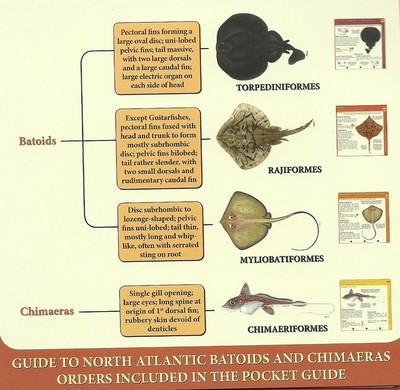North Atlantic Batoids and Chimaeras Relevant to Fisheries Management

A Pocket Guide

Introduction
This Pocket Guide present a fully illustrated identification guide to a selection of batoid and chimaera species of the North Atlantic. It encompasses FAO fishing area 27(Eastern North Atlantic) extending essentially from the North Pole to Latitude 36̊ N in the central Atlantic, bordered on the west by the coast of eastern Greenland and longitude 40̊ W in the Central North Atlantic, and area 21 (Western North Atlantic) from Eastern Greenland westwards to the Arctic waters of northern Canada at 120 ̊ W, and from northern Arctic waters at about 78 ̊ 10ʼN southwards to Cape Hatteras at 35 ̊ N
The North Atlantic batoid fauna is currently represented by fifty-six species, Thirty-three of which occur in area 27, seven in area 21, while sixteen species are widespread throughout both areas. Of the total of eight chimaera species known to occur in the North Atlantic, six are distributed throughout both areas, with two species occurring only area 27.
This Pocket guide includes thirty-three species of batoids and three chimaeras selected as being most relevant to commercial fisheries, vulnerable to exploitation due to their life history characteristics, or taken in large numbers as discarded by- catch. Each species is described, illustrated and its distribution mapped. Key distinguishing features of similar-looking species occurring in the same area are highlighted allowing for easy and accurate identification in the field.
Chimaeras are of very limited commercial interest only due to their deepwater habitat and rarity of most species. On the other hand, most batoid fishes are appreciated fishery subjects in many regions of their worldwide occurrence but share the same biological peculiarities as sharks, i.e. slow growth, late maturity, low reproductive rate, and can easily become overfished. Towards this direction, the EU, non-EU countries and regional fisheries management Organizations (RFMOs) have adapted conservation and management measures to reduce the impact of fisheries on elasmobranchs in the North Atlantic. Correct identification is of Primary importance in marine resource management.
Therefore, this pocket guide is aimed at fishery workers for the specific purpose of improving data collection at the species level for North Atlantic batoids and Chimaeras.



ساحة النقاش